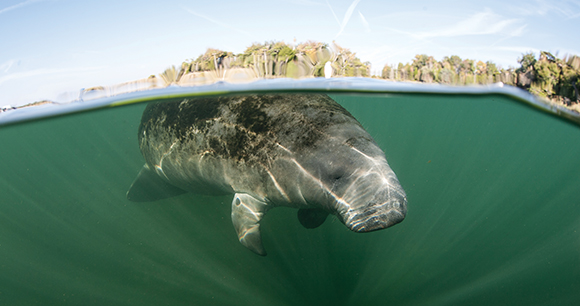by Julia Dombroski, Syracuse University
The Florida manatee (Trichechus manatus latirsotris) is an endemic subspecies of West Indian manatee that inhabits inland and coastal waters of the southeastern United States. Its population is threatened by natural and human-generated disturbances, including boat traffic, which may be ubiquitous throughout manatee habitat.

Boating is an important feature of the local culture and a $20 billion industry in Florida. In 2018, over 919,000 vessels were registered in the state. With the growth of coastal communities, the number of registered vessels is expected to increase about 8 percent in the next few years. Therefore, we can expect an increase in the frequency and intensity of interactions between boats and manatees. While starvation (linked to seagrass die-off) was the primary cause of manatee deaths in 2021, in recent years over 50 percent of direct human-related manatee deaths have been linked to interactions with motorized boats, which cause propeller wounds and/or blunt force trauma. In 2019, a record number of deaths (129) were attributed to vessel strikes. Vessels also elicit behavioral responses in manatees that vary according to individual and environmental factors. Yet, information on risk of exposure to vessel traffic and the variability in responses to such encounters is limited.
In this project, with funding from a Christine Stevens Wildlife Award from AWI, we investigated the levels of vessel traffic experienced by released manatees and how vessel exposure changed their behavior. To reach our goals, we integrated noninvasive digital acoustic recording tags into the animal’s tracking gear, thereby avoiding catching and restraining wild animals exclusively for the purposes of the project, while improving knowledge about the risks manatees face. The acoustic tags can record for up to 48 days, continuously capturing sounds produced by the animal, as well as boat noise, allowing us to detect when, where, and how often a manatee encounters boats and how they respond.
We deployed acoustic tags on 11 manatees. Results suggest that along Florida’s Atlantic Coast, individual manatees experience up to one close encounter with motorized boats per hour. Moreover, some of these encounters happen in key areas in the habitat, such as seagrass beds. We also found that an individual’s responsiveness to close vessel approaches varied; some demonstrated notable changes in acceleration when encountering a vessel, while others did not show quantifiable behavioral responses to a boat’s presence. In either case, there may be welfare implications. For example, important behaviors such as feeding may be interrupted when a manatee responds to boat noise. When boat noise elicits a flight response, it can affect the probability of animals being struck by vessels.
Demonstrating this variability in responsiveness is important to inform estimates of potential long-term effects of exposure to boat disturbance on Florida manatees. The special distribution of vessel encounters obtained by our study can be used to evaluate the effectiveness of boat traffic management in Florida and potentially trigger changes, for example, by imposing spatial or temporal restrictions on vessel access to seagrass beds, thereby helping to mitigate the pressure of vessel traffic on this vulnerable species.